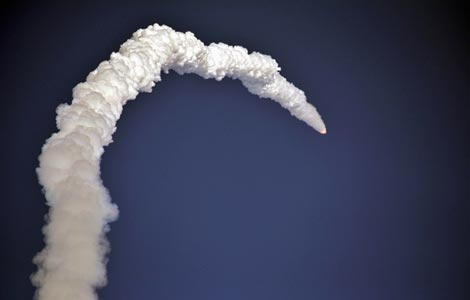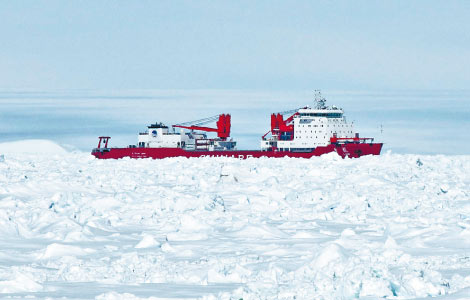Growing food in space could assist in human colonization
Updated: 2014-01-06 07:53
By Zhang Lei (China Daily)
|
||||||||
|
Biosphere 2 - a 1.27-hectare enclosed artificial ecosystem, in the desert, near Tucson, Arizona. Provided to China Daily |
Space, in the words of Captain James T. Kirk, is the final frontier. However, although the human colonization of space is central to the dreams of many aficionados of science fiction, only the most fanatical would contend that humans will achieve that ambition anytime soon.
The problems are manifold, ranging from solar radiation and frigid temperatures to the provision of adequate supplies of oxygen, food and water. Supplying space stations is almost prohibitively expensive. The United States spends between $10,000 and $100,000 to transport every kilogram of food it sends into space, and the huge distances between Earth and our nearest neighbors would render a resupply program almost impossible, even if humans were able to establish successful settlements outside Earth's atmosphere.
Now, however, it's hoped that research undertaken by a team of scientists at Beijing University of Aeronautics and Astronautics will provide some key answers to one of the problems - that of growing plants in space.
At their laboratory, called Yuegong-1, or Moon Palace, the scientists simulated a lunar environment - replicating the differences in temperature and gravity - to conduct experiments into the cultivation of plants and micro-organisms in an extraterrestrial environment.
The researchers used a limited number of resources; food, water, oxygen, soil, livestock, and, most important, plants with a strong resistance to the types of radiation found in space.
Ideal breeding conditions
The team, headed by Professor Liu Hong, is reported to have conducted successful tests on more than 10 plant varieties, including wheat, rice, soybeans, peanuts and peppers. Rice was the most-tested plant because it has a wider range of variations and the "space environment" provides ideal breeding conditions.
The model mimics the life cycle found on Earth; mature plants provide oxygen for survival, while decomposing human and animal waste, rich in essential amino acids and nitrogen, is used as a powerful fertilizer to promote the growth of more plants. To complete the cycle, atmospheric regeneration, water purification and the treatment and recycling of waste also take place.
While Liu declined to elaborate on the test procedures, such as the amount of oxygen and water used in the tests or the specific type of soil that would have to be carried into space, she said more details are likely to be made public after the Spring Festival holiday, which falls at the end of the month.
For Li Yinxin, a researcher at the Chinese Academy of Sciences' Institute of Botany, exo-cultivation is theoretically feasible.
Li, who in 2002 was a team leader in a project to construct life-support systems in the Xisha Islands in the South China Sea, said that, in theory, all life-support systems are the same, irrespective of whether they are situated on an island or in outer space.
"The model (at Yuegong-1) is called a Bio-regenerative Life Support System, otherwise known as a Controlled Ecological Life Support System. Chinese scientists have been working on this project for more than 30 years with the aim of finding plants capable of sustaining their growth cycles through adaptation to a previously unfriendly environment," she said.
Fu Dezhi, deputy director at CAS' South China Botanical Garden, who has spent more than 10 years researching space-cultivation programs, said the project is of theoretical significance and has a practical value.
The approach centers on analysis of crop mutations prompted by the exo-environment. The genetic variations induced by high levels of radiation and a weak gravitational pull, such as chromosomal changes and alterations to the structure of plant DNA and chemistry, can produce beneficial mutations, including new strains with higher yields and an improved resistance to pests.

 Offices of world leaders
Offices of world leaders
 First Taiwan-born panda makes public debut
First Taiwan-born panda makes public debut
 India successfully launches heavy lift rocket
India successfully launches heavy lift rocket
 Xuelong waits for chance to break free
Xuelong waits for chance to break free
 Fewer candidates take graduate entrance test
Fewer candidates take graduate entrance test
 Frigate escorts transport of Syria chemical weapons
Frigate escorts transport of Syria chemical weapons
 Putin, Belarussian president play ice hockey
Putin, Belarussian president play ice hockey
 Federer, Hewitt to meet in Brisbane final
Federer, Hewitt to meet in Brisbane final
Most Viewed
Editor's Picks

|

|

|

|

|

|
Today's Top News
Small plane crashes in Colorado
NYC Chinatown weathers killer storm
Program helps ex-inmates find work
'Life-threatening' cold bites US Midwest
Backing out of China to reshore
China keeps Africa as a key pillar
Major corruption cases up in 2013
New grads look abroad for first jobs
US Weekly

|

|







